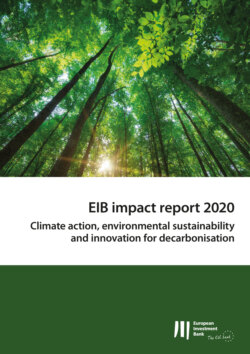Читать книгу EIB Impact Report 2020 - Группа авторов - Страница 5
На сайте Литреса книга снята с продажи.
ОглавлениеIntroduction
Welcome to the first edition of the European Investment Bank’s new impact report, the successor to the Bank’s annual EIB Operations inside the European Union report.
This new report takes a fresh look at how EIB operations improve lives around the world by measuring the effectiveness of our investments in three key areas:
• Additionality: The EIB’s role is to step in where the market has failed to deliver. The EIB has recently revised its internal procedures to enhance the assessment and measurement of its additionality, ensuring that the Bank’s presence in a project brings a quantifiable improvement over what would have otherwise been possible.
• Impact: The EIB now measures how its investments contribute to the United Nations Sustainable Development Goals (SDG). By doing so, the EIB is signalling its commitment to supporting the United Nations’ Decade of Action to create peace and prosperity for people and the planet. The Bank will continue to report regularly on the impact its global operations have on the SDGs.
• Climate: Because 2020 was the year the EIB assumed its new role as the European Union’s climate bank, this year’s report focuses on barriers to investment in climate action, environmental sustainability and research and development and innovation (RDI) for the decarbonisation of energy-intensive industries. This report takes a closer look at the barriers to investment and innovation, and explores how the EIB’s additionality can help investment in these critical sectors to flourish, making a difference to communities throughout the world.
IN A NUTSHELL
•The EIB delivers additionality and impact all over the world by supporting investment projects that address market failures in a wide variety of economic sectors, improving social welfare across the globe.
•In terms of contributions to the SDGs, the EIB’s reach is most notable in climate action and environmental sustainability, as well as in infrastructure investments.
•The EIB observes and identifies the investment barriers that can hold back projects and slow down economic development. The EIB’s long-time involvement and experience in financing a broad range of investment projects allows it to develop solutions that address some of these investment barriers.
•Fragmented regulation and fragmented markets across Europe, difficulties coordinating public funds and a lack of planning for public sector investments are holding back projects dealing with climate action, environmental sustainability and research and development for the decarbonisation of energy-intensive industries.
•The EIB has been able to improve the viability of projects by blending financing with the European Commission, by focusing on financial intermediaries that cater for small businesses working on climate action and environmental sustainability and by providing advisory services for investment projects.
Lastly, the report also provides a more technical assessment of the challenges facing investors in the economic sectors in which the EIB is particularly active. As the following chart illustrates, the Bank’s lending supports projects in a wide range of sectors in the European Union and beyond.
EIB’s lending mix over 2015-2020 (€ billion)
More information relating to EU operations is available on the EIB’s website, in the form of project stories and data.
